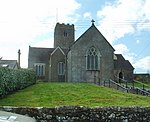Newbridge, River Dart

Newbridge or New Bridge is a Grade II* listed medieval bridge over the River Dart, Dartmoor, Devon, England. It is on the road between Ashburton and Two Bridges, and connects Aish Tor to Holne Chase. A car park is located next to the bridge and is often frequented by families, walkers, and watersports enthusiasts, though the narrowness of both this bridge and Holne Bridge means that the size of vehicles is restricted on this road.The bridge is constructed of local granite and has three semicircular arches, one smaller than the others. It was built in 1413, at the same time as the nearby Holne Bridge was reconstructed. The two pillars have cutwaters to deflect the flow of water; these extend up to road level and provide triangular refuges for pedestrians.
Excerpt from the Wikipedia article Newbridge, River Dart (License: CC BY-SA 3.0, Authors, Images).Newbridge, River Dart
New Bridge, South Hams Holne
Geographical coordinates (GPS) Address External links Nearby Places Show on map
Geographical coordinates (GPS)
| Latitude | Longitude |
|---|---|
| N 50.5235 ° | E -3.8191 ° |
Address
New Bridge (Newbridge)
New Bridge
TQ13 7NT South Hams, Holne
England, United Kingdom
Open on Google Maps









